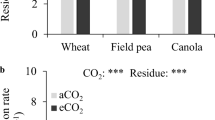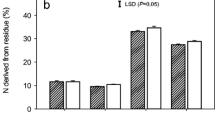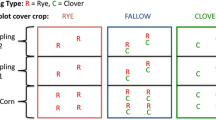Abstract
The effects of elevated atmospheric carbon dioxide (eCO2) on belowground processes are known to occur directly and indirectly via plants. However, the long-term impact of eCO2 on biochemical properties and processes of agricultural soils in the absence of plants is unclear. The current study investigated whether residue decomposition and the subsequent ‘priming effect’ on soil organic C (SOC) mineralisation were altered in three contrasting soils previously exposed to either ambient CO2 (aCO2; 390 ppm) or eCO2 (550 ppm) using free-air CO2 enrichment (FACE) for 4 years. Surface soils (0–2 cm) of calcisol, luvisol and vertisol were amended (0.5% w w−1) with 13C-labelled field pea (Pisum sativum L. cv. PBA; C:N 20) or wheat (Triticum aestivum cv. Yitpi; C:N 60) residues, and CO2 derived from soil (CO2 soil) and residue (CO2 residue) were quantified over the 96-day incubation study. Field pea decomposition was not affected by soil type or CO2 history, and the decomposition of wheat was similar in all soils previously exposed to aCO2. However, wheat decomposition was increased in luvisol (14.4%), decreased in vertisol (26.7%) or not affected by eCO2 in the calcisol. The relative differences between soils were largely driven by labile N content and the potential to replenish inorganic N via mineralisation. Notably, priming was not influenced by residue type, despite their contrasting N content. In the calcisol, lower basal C mineralisation and C priming under eCO2 were not explained by lower N concentrations. A greater priming effect in field pea–amended vertisol previously exposed to eCO2 than aCO2 was likely due to overcoming the N limitation on microbial C mineralisation in this soil. Overall, the study highlighted that C mineralisation was mainly determined by soil N status, less by CO2 history and least by residue quality (C:N ratio).


Similar content being viewed by others
References
Abiven S, Recous S, Reyes V, Oliver R (2005) Mineralisation of C and N from root, stem and leaf residues in soil and role of their biochemical quality. Biol Fertil Soils 42:119–128
Ainsworth EA, Long SP (2005) What have we learned from 15 years of free-air CO2 enrichment (FACE)? A meta-analytic review of the responses of photosynthesis, canopy properties and plant production to rising CO2. New Phytol 165:351–371
Ainsworth EA, Rogers A (2007) The response of photosynthesis and stomatal conductance to rising CO2: mechanisms and environmental interactions. Plant Cell Environ 30:258–270
Allard V, Robin C, Newton PCD, Lieffering M, Soussana JF (2006) Short and long-term effects of elevated CO2 on Lolium perenne rhizodeposition and its consequences on soil organic matter turnover and plant N yield. Soil Biol Biochem 38:1178–1187
Allison SD, Martiny JBH (2008) Resistance, resilience, and redundancy in microbial communities. Proc Natl Acad Sci U S A 105:11512–11519
Baldock JA, Wheeler I, McKenzie N, McBrateny A (2012) Soils and climate change: potential impacts on carbon stocks and greenhouse gas emissions, and future research for Australian agriculture. Crop Pasture Sci 63:269–283
Blagodatskaya E, Blagodatsky S, Dorodnikov M, Kuzyakov Y (2010) Elevated atmospheric CO2 increases microbial growth rates in soil: results of three CO2 enrichment experiments. Glob Chang Biol 16:836–848
Blagodatskaya E, Kuzyakov Y (2013) Active microorganisms in soil: critical review of estimation criteria and approaches. Soil Biol Biochem 67:192–211
Brookes PC, Landman A, Pruden G, Jenkinson DS (1985) Chloroform fumigation and the release of soil nitrogen: a rapid direct extraction method to measure microbial biomass nitrogen in soil. Soil Biol Biochem 17:837–842
Butterly CR, Armstrong R, Chen D, Tang C (2015) Carbon and nitrogen partitioning of wheat and field pea grown with two nitrogen levels under elevated CO2. Plant Soil 391:367–382
Butterly CR, Armstrong RD, Chen D, Tang C (2016a) Free-air CO2 enrichment (FACE) reduces the inhibitory effect of soil nitrate on N2 fixation of Pisum sativum L. Ann Bot 117:177–185
Butterly CR, Bünemann EK, McNeill AM, Baldock JA, Marschner P (2009) Carbon pulses but not phosphorus pulses are related to decreases in microbial biomass during repeated drying and rewetting of soils. Soil Biol Biochem 41:1406–1416
Butterly CR, Phillips LA, Wiltshire JL, Franks AE, Armstrong RD, Chen D, Mele PM, Tang C (2016b) Long-term effects of elevated CO2 on carbon and nitrogen functional capacity of microbial communities in three contrasting soils. Soil Biol Biochem 97:157–167
Butterly CR, Wang X, Armstrong RD, Chen D, Tang C (2016c) Elevated CO2 induced rhizosphere effects on the decomposition and N recovery from crop residues. Plant Soil 408:55–71
Cabrera ML, Beare MH (1993) Alkaline persulfate oxidation for determining total nitrogen in microbial biomass extracts. Soil Sci Soc Am J 57:1007–1012
Carney KM, Hungate BA, Drake BG, Megonigal JP (2007) Altered soil microbial community at elevated CO2 leads to loss of soil carbon. Proc Natl Acad Sci U S A 104:4990–4995
Carrillo Y, Dijkstra F, Pendall E, LeCain D, Tucker C (2014) Plant rhizosphere influence on microbial C metabolism: the role of elevated CO2, N availability and root stoichiometry. Biogeochemistry 117:229–240
Chen R, Senbayram M, Blagodatsky S, Myachina O, Dittert K, Lin X, Blagodatskaya E, Kuzyakov Y (2014) Soil C and N availability determine the priming effect: microbial N mining and stoichiometric decomposition theories. Glob Chang Biol 20:2356–2367
Cheng L, Booker FL, Tu C, Burkey KO, Zhou LS, Shew HD, Rufty TW, Hu SJ (2012) Arbuscular mycorrhizal fungi increase organic carbon decomposition under elevated CO2. Science 337:1084–1087
Cheng WX (1999) Rhizosphere feedbacks in elevated CO2. Tree Physiol 19:313–320
Cheng WX, Johnson DW (1998) Elevated CO2, rhizosphere processes, and soil organic matter decomposition. Plant Soil 202:167–174
Craine JM, Morrow C, Fierer N (2007) Microbial nitrogen limitation increases decomposition. Ecology 88:2105–2113
de Graaff M-A, Classen AT, Castro HF, Schadt CW (2010) Labile soil carbon inputs mediate the soil microbial community composition and plant residue decomposition rates. New Phytol 188:1055–1064
de Graaff M-A, van Groenigen K-J, Six J, Hungate B, van Kessel C (2006) Interactions between plant growth and soil nutrient cycling under elevated CO2: a meta-analysis. Glob Chang Biol 12:2077–2091
de Graaff MA, Six J, Harris D, Blum H, van Kessel C (2004) Decomposition of soil and plant carbon from pasture systems after 9 years of exposure to elevated CO2: impact on C cycling and modeling. Glob Chang Biol 10: 1922–1935
de Graaff MA, Six J, van Kessel C (2007) Elevated CO2 increases nitrogen rhizodeposition and microbial immobilization of root-derived nitrogen. New Phytol 173:778–786
de Graaff MA, Van Kessel C, Six J (2009) Rhizodeposition-induced decomposition increases N availability to wild and cultivated wheat genotypes under elevated CO2. Soil Biol Biochem 41:1094–1103
Drigo B, Kowalchuk GA, Knapp BA, Pijl AS, Boschker HTS, van Veen JA (2013) Impacts of 3 years of elevated atmospheric CO2 on rhizosphere carbon flow and microbial community dynamics. Glob Chang Biol 19: 621–636
Drissner D, Blum H, Tscherko D, Kandeler E (2007) Nine years of enriched CO2 changes the function and structural diversity of soil microorganisms in a grassland. Eur J Soil Sci 58:260–269
Fang HJ, Cheng SL, Lin ED, Yu GR, Niu SL, Wang YS, Xu MJ, Dang XS, Li LS, Wang L (2015) Elevated atmospheric carbon dioxide concentration stimulates soil microbial activity and impacts water-extractable organic carbon in an agricultural soil. Biogeochemistry 122:253–267
Fontaine S, Bardoux G, Abbadie L, Mariotti A (2004) Carbon input to soil may decrease soil carbon content. Ecol Lett 7:314–320
Guenet B, Lenhart K, Leloup J, Giusti-Miller S, Pouteau V, Mora P, Nunan N, Abbadie L (2012) The impact of long-term CO2 enrichment and moisture levels on soil microbial community structure and enzyme activities. Geoderma 170:331–336
Hayden HL, Mele PM, Bougoure DS, Allan CY, Norng S, Piceno YM, Brodie EL, DeSantis TZ, Andersen GL, Williams AL, Hovenden MJ (2012) Changes in the microbial community structure of bacteria, archaea and fungi in response to elevated CO2 and warming in an Australian native grassland soil. Environ Microbiol 14:3081–3096
He Z, Xiong J, Kent AD, Deng Y, Xue K, Wang G, Wu L, Van Nostrand JD, Zhou J (2014) Distinct responses of soil microbial communities to elevated CO2 and O3 in a soybean agro-ecosystem. ISME J 8: 714–726
He ZL, Xu MY, Deng Y, Kang SH, Kellogg L, Wu LY, Van Nostrand JD, Hobbie SE, Reich PB, Zhou JZ (2010) Metagenomic analysis reveals a marked divergence in the structure of belowground microbial communities at elevated CO2. Ecol Lett 13: 564–575
Heanes DL (1984) Determination of total organic-C in soils by an improved chromic acid digestion and spectrophotometric procedure. Commun Soil Sci Plant Anal 15:1191–1213
IPCC (2014) Climate change 2014: impacts, adaptation and vulnerability. Part A: global and sectoral aspects. In: CB field, VR Barros, DJ Dokkenet al (Eds) Working group II contribution to the intergovernmental panel on climate change fifth assessment report. Cambridge University Press, Cambridge, United Kingdom, pp 1–1967
Isbell RF (1996) The Australian soil classification. CSIRO Publishing, Melbourne
Jensen ES (1997) Nitrogen immobilization and mineralization during initial decomposition of 15N-labelled pea and barley residues. Biol Fertil Soils 24:39–44
Jin J, Tang C, Armstrong R, Butterly C, Sale P (2013) Elevated CO2 temporally enhances phosphorus immobilization in the rhizosphere of wheat and chickpea. Plant Soil 368:315–328
Joergensen RG (1996) The fumigation-extraction method to estimate soil microbial biomass: calibration of the kEC value. Soil Biol Biochem 28:25–31
Kimball BA, Kobayashi K, Bindi M (2002) Responses of agricultural crops to free-air CO2 enrichment. Adv Agron 77:293–368
Kou T, Zhu J, Xie Z, Hasegawa T, Heiduk K (2007) Effect of elevated atmospheric CO2 concentration on soil and root respiration in winter wheat by using a respiration partitioning chamber. Plant Soil 299:237–249
Lam SK, Norton R, Armstrong R, Chen D (2014) Increased microbial activity under elevated [CO2] does not enhance residue decomposition in a semi-arid cropping system in Australia. Soil Biol Biochem 72:97–99
Liu Y, Zhang H, Xiong M, Li F, Li L, Wang G, Pan G (2017) Abundance and composition response of wheat field soil bacterial and fungal communities to elevated CO2 and increased air temperature. Biol Fertil Soils 53:3–8
Luo Y, Su B, Currie WS, Dukes JS, Finzi AC, Hartwig U, Hungate B, McMurtrie RE, Oren R, Parton WJ, Pataki DE, Shaw MR, Zak DR, Field CB (2004) Progressive nitrogen limitation of ecosystem responses to rising atmospheric carbon dioxide. Bioscience 54:731–739
Marhan S, Derain D, Erbs M, Kuzyakov Y, Fangmeier A, Kandeler E (2008) Soil organic matter mineralization and residue decomposition of spring wheat grown under elevated CO2 atmosphere. Agric Ecosyst Environ 123:63–68
Martens R, Heiduk K, Pacholski A, Weigel HJ (2009) Repeated 14CO2 pulse-labelling reveals an additional net gain of soil carbon during growth of spring wheat under free air carbon dioxide enrichment (FACE). Soil Biol Biochem 41:2422–2429
Mollah M, Norton R, Huzzey J (2009) Australian grains free-air carbon dioxide enrichment (AGFACE) facility: design and performance. Crop Pasture Sci 60:697–707
Norby RJ, Cotrufo MF, Ineson P, O'Neill EG, Canadell JG (2001) Elevated CO2, litter chemistry, and decomposition: a synthesis. Oecologia 127:153–165
Norby RJ, Zak DR (2011) Ecological lessons from free-air CO2 enrichment (FACE) experiments. Annu Rev Ecol Evol Syst 42:181–203
Pendall E, Bridgham S, Hanson PJ, Hungate B, Kicklighter DW, Johnson DW, Law BE, Luo YQ, Megonigal JP, Olsrud M, Ryan MG, Wan SQ (2004) Below-ground process responses to elevated CO2 and temperature: a discussion of observations, measurement methods, and models. New Phytol 162:311–322
Pendall E, Leavitt SW, Brooks T, Kimball BA, Pinter PJ, Wall GW, LaMorte RL, Wechsung G, Wechsung F, Adamsen F, Matthias AD, Thompson TL (2001) Elevated CO2 stimulates soil respiration in a FACE wheat field. Basic Appl Ecol 2:193–201
Procter AC, Ellis JC, Fay PA, Polley HW, Jackson RB (2014) Fungal community responses to past and future atmospheric CO2 differ by soil type. Appl Environ Microbiol 80:7364–7377
Reinsch S, Ambus P, Thornton B, Paterson E (2013) Impact of future climatic conditions on the potential for soil organic matter priming. Soil Biol Biochem 65:133–140
Sanderman J, Maddern T, Baldock J (2014) Similar composition but differential stability of mineral retained organic matter across four classes of clay minerals. Biogeochemistry 121:409–424
Shahbaz M, Kuzyakov Y, Sanaullah M, Heitkamp F, Zelenev V, Kumar A, Blagodatskaya E (2017) Microbial decomposition of soil organic matter is mediated by quality and quantity of crop residues: mechanisms and thresholds. Biol Fertil Soils 53:287–301
Six J, Paustian K, Elliott ET, Combrink C (2000) Soil structure and organic matter I. distribution of aggregate-size classes and aggregate-associated carbon. Soil Sci Soc Am J 64:681–689
Sparling G, Zhu C (1993) Evaluation and calibration of biochemical methods to measure microbial biomass C and N in soils from Western Australia. Soil Biol Biochem 25:1793–1801
Sulman BN, Phillips RP, Oishi AC, Shevliakova E, Pacala SW (2014) Microbe-driven turnover offsets mineral-mediated storage of soil carbon under elevated CO2. Nat Clim Chang 4:1099–1102
Torbert HA, Prior SA, Rogers HH, Wood CW (2000) Review of elevated atmospheric CO2 effects on agro-ecosystems: residue decomposition processes and soil C storage. Plant Soil 224:59–73
van Groenigen K-J, Six J, Hungate BA, de Graaff M-A, van Breemen N, van Kessel C (2006) Element interactions limit soil carbon storage. Proc Natl Acad Sci U S A 103: 6571–6574
van Groenigen KJ, Qi X, Osenberg CW, Luo YQ, Hungate BA (2014) Faster decomposition under increased atmospheric CO2 limits soil carbon storage. Science 344:508–509
Vance ED, Brookes PC, Jenkinson DS (1987) An extraction method for measuring soil microbial biomass C. Soil Biol Biochem 19:703–707
Viswanath T, Pal D, Purakayastha TJ (2010) Elevated CO2 reduces rate of decomposition of rice and wheat residues in soil. Agric Ecosyst Environ 139:557–564
WRB IWG (2014) World reference base for soil resources. International soil classification system for naming soils and creating legends for soil maps. FAO, Rome
Xu MY, He ZL, Deng Y, Wu LY, van Nostrand JD, Hobbie SE, Reich PB, Zhou JZ (2013) Elevated CO2 influences microbial carbon and nitrogen cycling. BMC Microbiol 13: 124
Yang Y, Luo Y, Lu M, Schaedel C, Han W (2011) Terrestrial C:N stoichiometry in response to elevated CO2 and N addition: a synthesis of two meta-analyses. Plant Soil 343:393–400
Zibilske LM (1994) Carbon mineralization methods of soil analysis, part 2 microbial and biochemical properties. Soil Science Society of America, Madison, WI, pp 835–863
Acknowledgements
We are grateful to Kaien Ra for her excellent technical support, Leanne Lisle for performing the IRMS analyses and Patrick Bloye who worked on this project as part of his Honours project. The SoilFACE facility is part of The Australian Grains Free Air CO2 Enrichment (AGFACE) facility, which is jointly operated by The University of Melbourne and DEDJTR with funding from the Grains Research and Development Corporation (GRDC) and the Australian Government Department of Agriculture. We thank the SoilFACE technical team for managing the field experiment and Mahabubur Mollah for the FACE infrastructure.
Funding
This research was supported by an Australian Research Council Linkage Project (LP100200757) and was conducted the Department of Economic Development, Jobs, Transport and Resources (DEDJTR), Victoria at Horsham.
Author information
Authors and Affiliations
Corresponding authors
Electronic supplementary material
Supplementary Figure 1
(DOCX 74 kb)
Supplementary Figure 2
(DOCX 105 kb)
Rights and permissions
About this article
Cite this article
Butterly, C.R., Armstrong, R.D., Chen, D. et al. Residue decomposition and soil carbon priming in three contrasting soils previously exposed to elevated CO2. Biol Fertil Soils 55, 17–29 (2019). https://doi.org/10.1007/s00374-018-1321-6
Received:
Revised:
Accepted:
Published:
Issue Date:
DOI: https://doi.org/10.1007/s00374-018-1321-6




